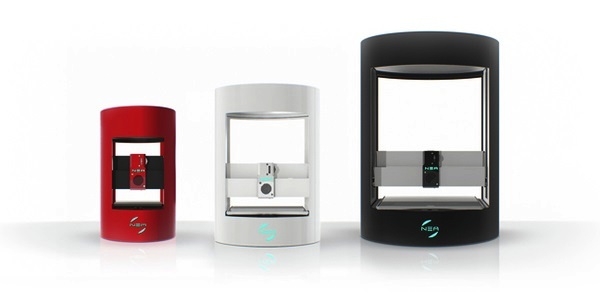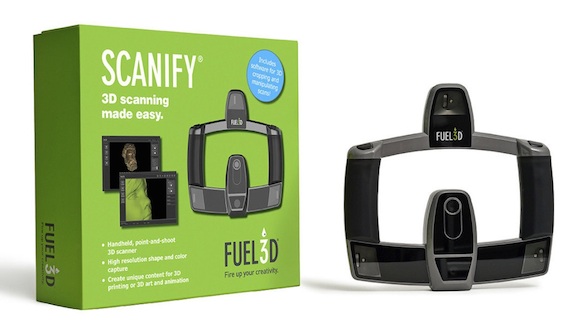BreakingModern — Are you willing to pay $399 for a home 3-D printer? A new product in this ballpark is due to be ready in time for the next holiday season and beyond, according to participants in CE Week in New York City.
These days, 3-D printers are getting faster, and prices on printing materials are coming down. And, you can now print on unlikely media such as coffee and chocolate, said Robin Raskin, founder and president Living in Digital Times, in a presentation at CE Week on trends we’ll see at the big show in Las Vegas next January.

The Consumer Electronics Association (CEA), sponsor of both events, made the new trends in 3-D scanners abundantly evident right from the start at CE Week. Visitors in attendance for ShowStoppers’ Media Breakfast were greeted by reps from Ripples offering free cups of cappuccino, with “It’s a pleasure to serve you” and an assortment of other messages emblazoned on top.
The company’s Ripple Maker printer brings together 3-D and inkjet technologies with coffee extract to draw pictures in the foam. Through a Ripples smartphone app, customers can either select canned messages or use their own photos and texts to produce custom statements for the cups of coffees.
Coming Soon in Airport Cafes
A model dolled up in a Lufthansa flight attendant outfit stood close at hand, reflecting the airline’s new move to use The Ripple Maker at its airport lounges.
If you think you might like one of these 3-D contraptions for your kitchen, think again. It’s only available to coffee shops and other restaurants. On top of the $999 purchase price, customers must pay monthly maintenance fees starting at $75.

The $399 Gadget from New Matter
If you really do want a more conventional (and affordable) 3-D printer to call your own, you can already pre-order the $399 Mod-t gizmo from the New Matter website. Shipment was originally set for June, but has now been pushed back to September for all except some of those who pre-ordered some time ago on IndieGoGo.
Although 3-D printers in this price league are already available, the Mod-t is different in a couple of important ways, said staffers at the New Matter booth. For one thing, the Mod-t comes with built-in Wi-Fi for wireless connectivity to a PC or Mac. Then, from the New Matter online store, you can choose from a selection of preset 3-D models and simply print them out on the Mod-t printer.
Do you want to get fancier with your 3-D printing? Then you can import custom 3-D printing files in industry standard STL format. The New Matter printer uses standard Polyactic Acid (PLA) materials for printing out the 3-D objects.
New Matter is gearing the 3-D printer to folks like teachers and kids who want to make toys, parents needing game pieces to fill out sets and hobbyists and artists.
Printing at speeds up to 80 mm per second, the Mod-t can create objects measuring up to 6 x 4 x 5 inches.

A Higher-End 3-D Printer
In case your 3-D printing interests lie at the higher end, a startup named NEA previewed three models in an upcoming series targeted at small businesses, prosumers, workshops, studios and institutions.
While most 3-D printers in this price bracket are belt-driven, the NEA NeatStuff scanners use “a unique two-axis drive system” for smoother operation, said Byron Kent Wong, NEA’s director of brand and strategy. An NEA 3-D printer could even be used to build a prosthetic limb, he added. Availability is expected in October or November.
Like New Matter, NEA 3-D is being crowd funded through IndieGoGo. The three models of NEA 3-D printers include the entry-level Mini (already sold out in pre-orders), the Pro, currently priced at $845, and the Pro Plus, pre-orderable for $1,395. Prices are substantially higher after the IndieGoGo campaign ended on July 3.
What About 3-D Scanning?
In most cases, practitioners of 3-D printing also need a 3-D scanner for scanning objects and producing STL, PLY and OBJ export files. Scanify, another exhibitor at CE Week, already has such a product on the market, sold at B&H stores for $1,490.
Scanify displayed its Fuel 3-D scanner alongside the 3-D mask of a face of one of the company’s staffers, created from a photo. But that’s nothing new, said Kat Young, consumer market manager. During a previous show, Scanify displayed an entire gallery of masks of company employees, entitled “Our Colleagues.”
Young also rattled off a list of other use scenarios for 3-D scanning and printing. People can use the technology for historical and educational purposes, taking a 2-D photo or drawing of some historical figure and then turning it into a 3-D representation for presentation in a museum or classroom setting, for instance.
Also, foot doctors or their associates can use 3-D technology for building custom orthotics — the kinds of contraptions that fit into shoes to make walking around a more comfortable experience for those with foot troubles.
Other uses include capturing 3-D models of plants and laves, fabrics, stone and brick masonry, textured paintings, clay sculptures and wood carvings, for example.
Is the Mass Market Ready Yet?
Personally, I wouldn’t spend $399 or more on a 3-D printer, because I don’t see any compelling need to have one in my life. In an off-the-cuff discussion at CE Week, Avi Greengart, an analyst at Current Analysis, said that he agrees with me. “I wouldn’t even pay $100 for a 3-D printer, and I don’t think most consumers would, at this point,” he said.
Crowd Funding
On the other hand, somebody must want these products, because crowd funding is going well. As of June 24, NEA had already raised $225,000 through IndieGoGo, more than 250 percent of its initial goal.
Crowd funding, by the way, is now replacing venture capital (VC) funding as the most popular way for startups and new products to get to market. An exec at PowerGoGo, another exhibitor at CE Week, said his company is launching a “crowd awareness” campaign for its new lineup of car mountable magnetic wireless chargers for the iPhone. PowerGoGo, though, is foregoing IndieGoGo in favor of working with a crowd funding consulting firm.
For BMod, I’m Jacqueline Emigh.
All Screenshots: Jacqueline Emigh








![Who’s Going to Get “Lucky” This NBA Season? [commentary]](../wp-content/uploads/2015/10/HEADER4-60x60.jpg)
![Pete Rose Continues to be Out of Step with Major League Baseball [commentary]](../wp-content/uploads/2015/10/HEADER2-60x60.png)

![Cooking Fever [review]](../wp-content/uploads/2015/11/HEADER1-321x214.png)
![Assassin’s Creed Syndicate [review]](../wp-content/uploads/2015/11/HEADER3-60x60.jpg)
![The Legend of Zelda: A Link to the Past [manga review]](../wp-content/uploads/2015/10/HEADER3-60x60.png)
![Madden NFL Mobile [review]](../wp-content/uploads/2015/09/header3-60x60.jpg)